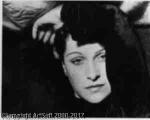Dora Maar
Dora Maar
Stil: Surrealism;
Plats: Paris
Född: 1907
Död: 1973
Biografi:
Henriette Theodora Markovitch with Pierre Kéfer, photographer, and decorator for Jean Epstein's 1928 film, The Fall of the House of Usher. In the studio, Maar and Kefer worked together mostly on commercial photography for advertisements and fashion magazines.
She met the photographer Brassaï with whom she shared the darkroom in the studio. Brassai once said that she had, “bright eyes and an attentive gaze, a disturbing stare at times.”
Dora Maar also met Louis-Victor Emmanuel Sougez, a photographer working for advertising, archeology and artistic director of the newspaper L'Illustration, whom she considered a mentor.
In 1932, she had an affair with the filmmaker Louis Chavance. Dora Maar frequented the October group, formed around Jacques Prévert and Max Morise after their break from surrealism.
Maar had her first publication in the magazine Art et Métiers Graphiques in 1932.
Her first solo exhibition was held at the Galerie Vanderberg in Paris.
After the fascist demonstrations of 6 February 1934, in Paris along with René Lefeuvre, Jacques Soustelle, supported by Simone Weil and Georges Bataille, she signed the tract "Appeal to the struggle" written at the initiative of André Breton. Much of her work is highly influenced by leftist politics of the time, often depicting those who had been thrown into poverty by the depression. She was part of an ultra-leftist association called “Masses,” where she first met Georges Bataille, an anti-fascist organization called "The Union of Intellectuals Against Fascism" and a radical collective of left-wing actors and writers called October.
She also was involved in many Surrealist groups and often participated in demonstrations, convocations, and cafe conversations. She signed many manifestos including one titled 'when surrealists were right' in August of 1935 which concerned the Congress of Paris, which had been held in March of that year.
In 1935 she took a photo of fashion illustrator and designer Christian Berard that was described by writer and critic Michael Kimmelman as, “wry and mischievous with only his head perceived above the fountain as if he were john the baptist on a silver platter.”
At the end of 1935, Dora Maar was hired as a set photographer on the Jean Renoir film The Crime of Monsieur Lange. On this occasion Paul Eluard introduced her to Pablo Picasso. Their liaison would last nearly nine years, without Picasso nevertheless breaking his relationship with Marie-Thérèse Walter, mother of his daughter Maya.
Dora Maar photographed the successive stages of the creation of Guernica, painted by Picasso in his studio in the rue des Grands-Augustins from May to June 1937; Picasso used these photographs in his creative process. At the same time, she is the principal model of Picasso, who often represents her in tears, she, herself produced several self-portraits entitled: La Femme qui pleure – The Weeping Woman.
More...
Wikipedia link: Click Here



